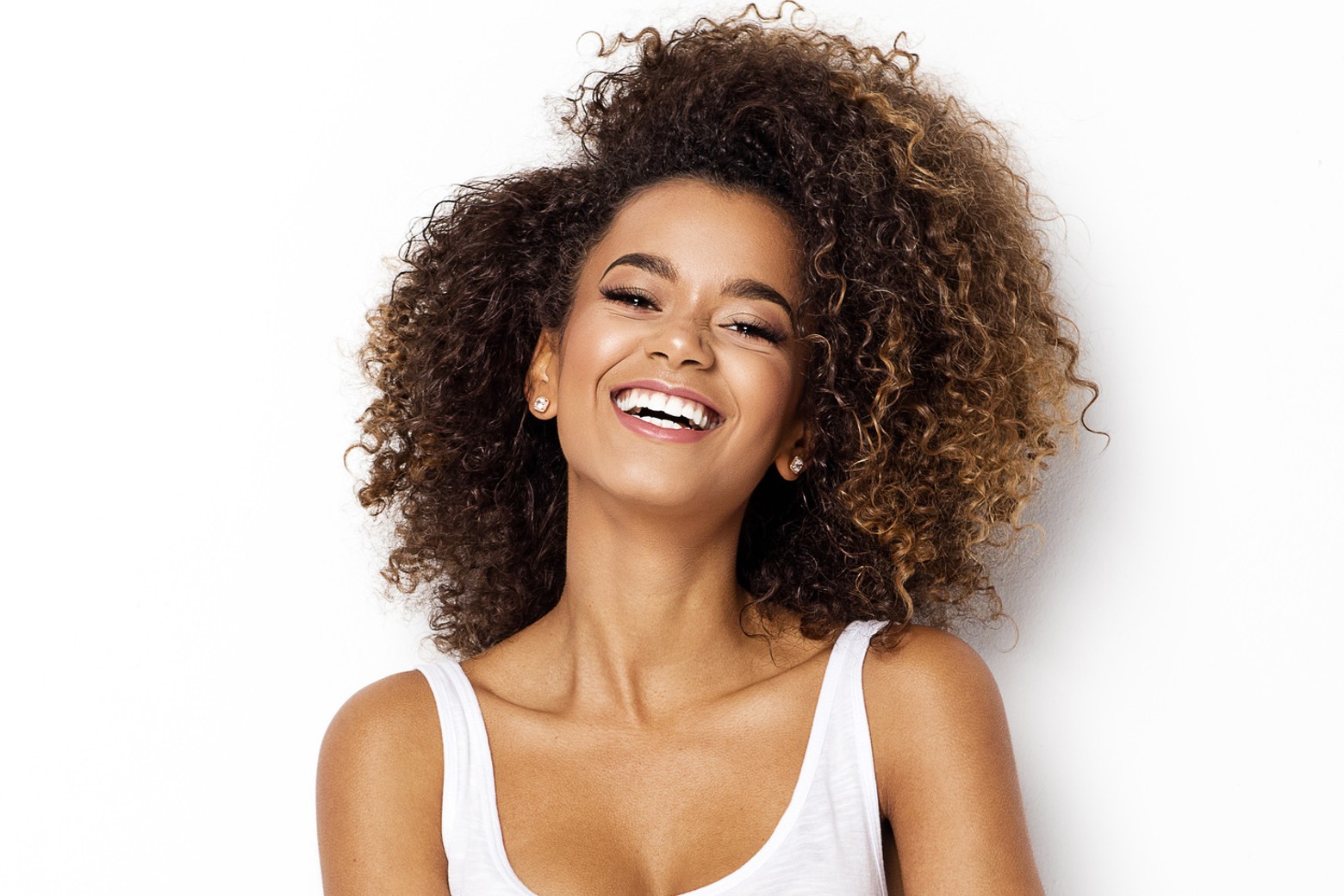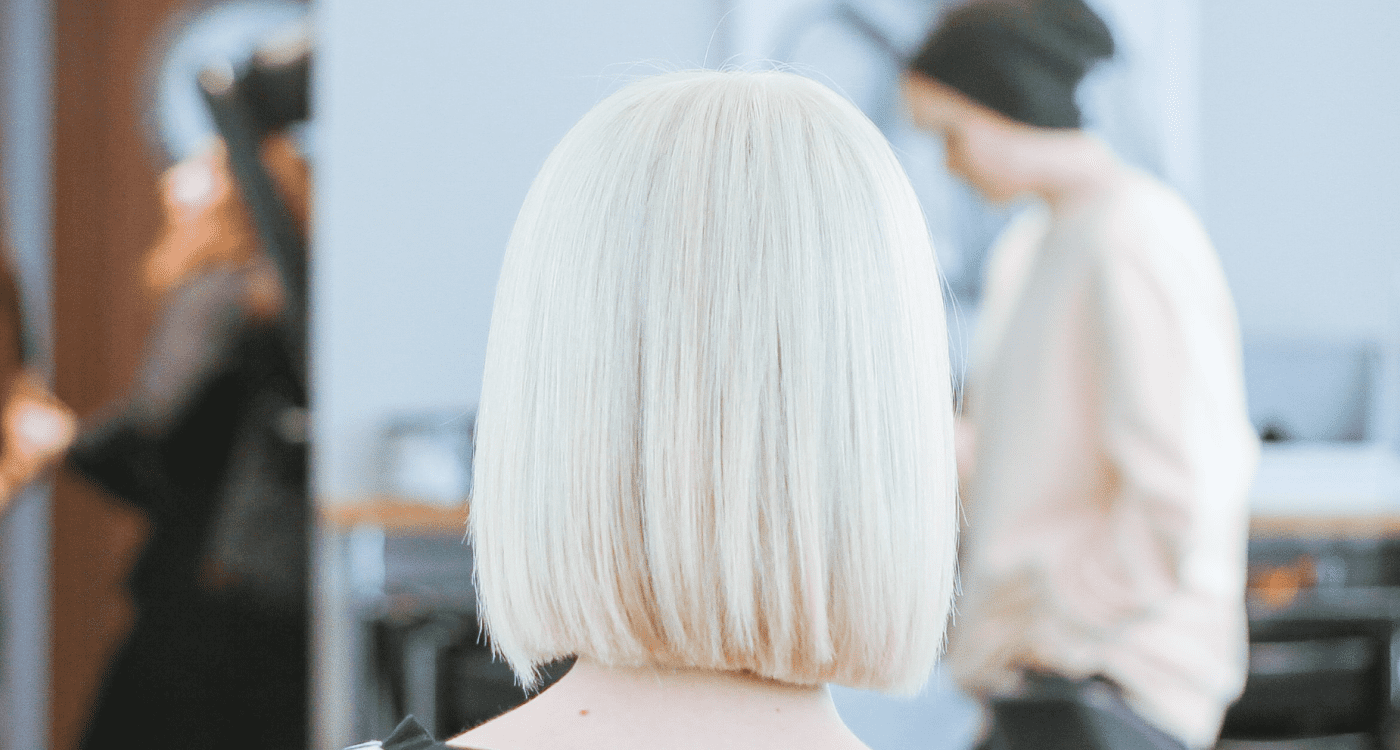Hair Textures: A Guide To Finding Your Type
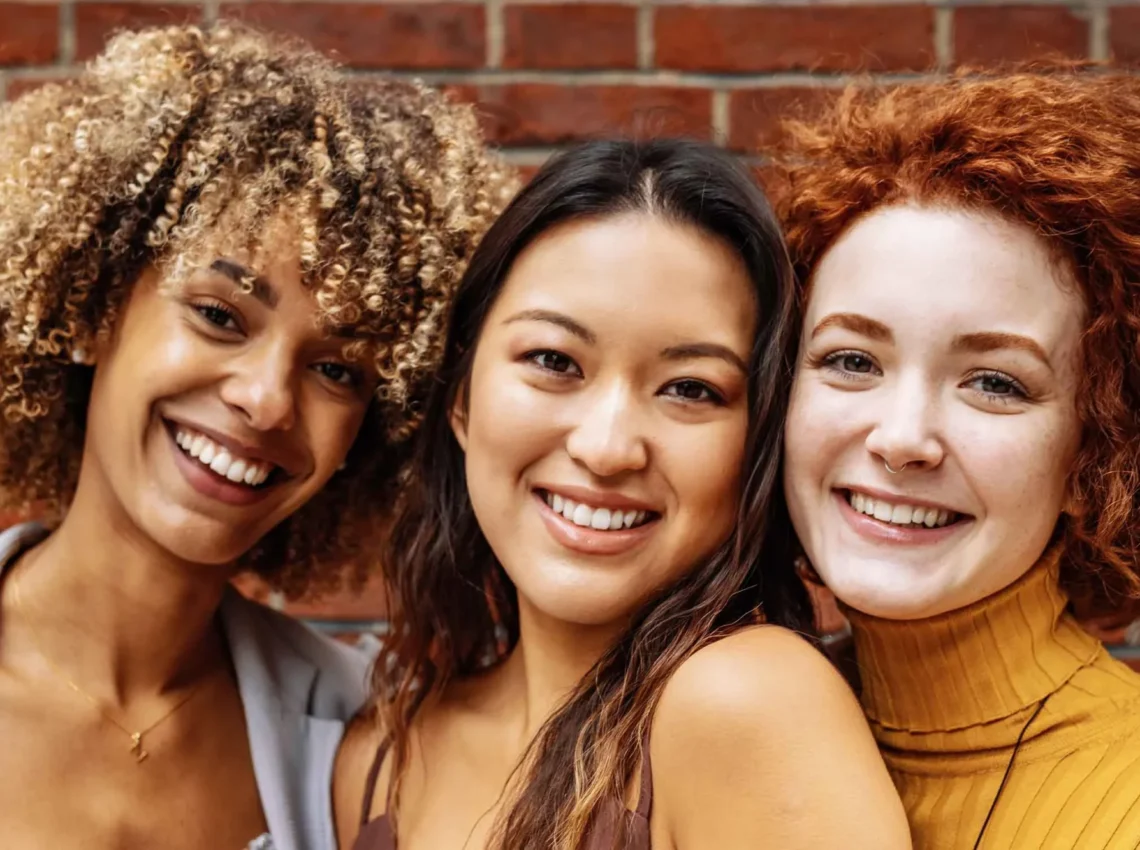
Do you know the difference between Type 3C and 4A hair? If the answer is no, don’t worry — understanding hair textures can be confusing. There are lots of hair texture definitions and categories that differ based on the stylist. Despite this, it’s useful to know what hair type you have.
Generally knowing your hair types can help you understand how to care for and style your hair. For example, certain hair types need more conditioning than others, while others have specific styling needs.
We’ve put together this guide to walk you through the different types of hair textures and what you need to know to take care of yours, so you can make your next hair appointment with confidence.
What is textured hair?
Textured hair refers to hair strands that create a shape like coils or waves. Essentially, it’s any hair type that’s not straight. Contrary to the name, textured hair doesn’t have anything to do with how your hair feels. Some people use the term “textured hair” when talking about the hair of people in the black community, but these things are not mutually exclusive.
What are the different hair textures?
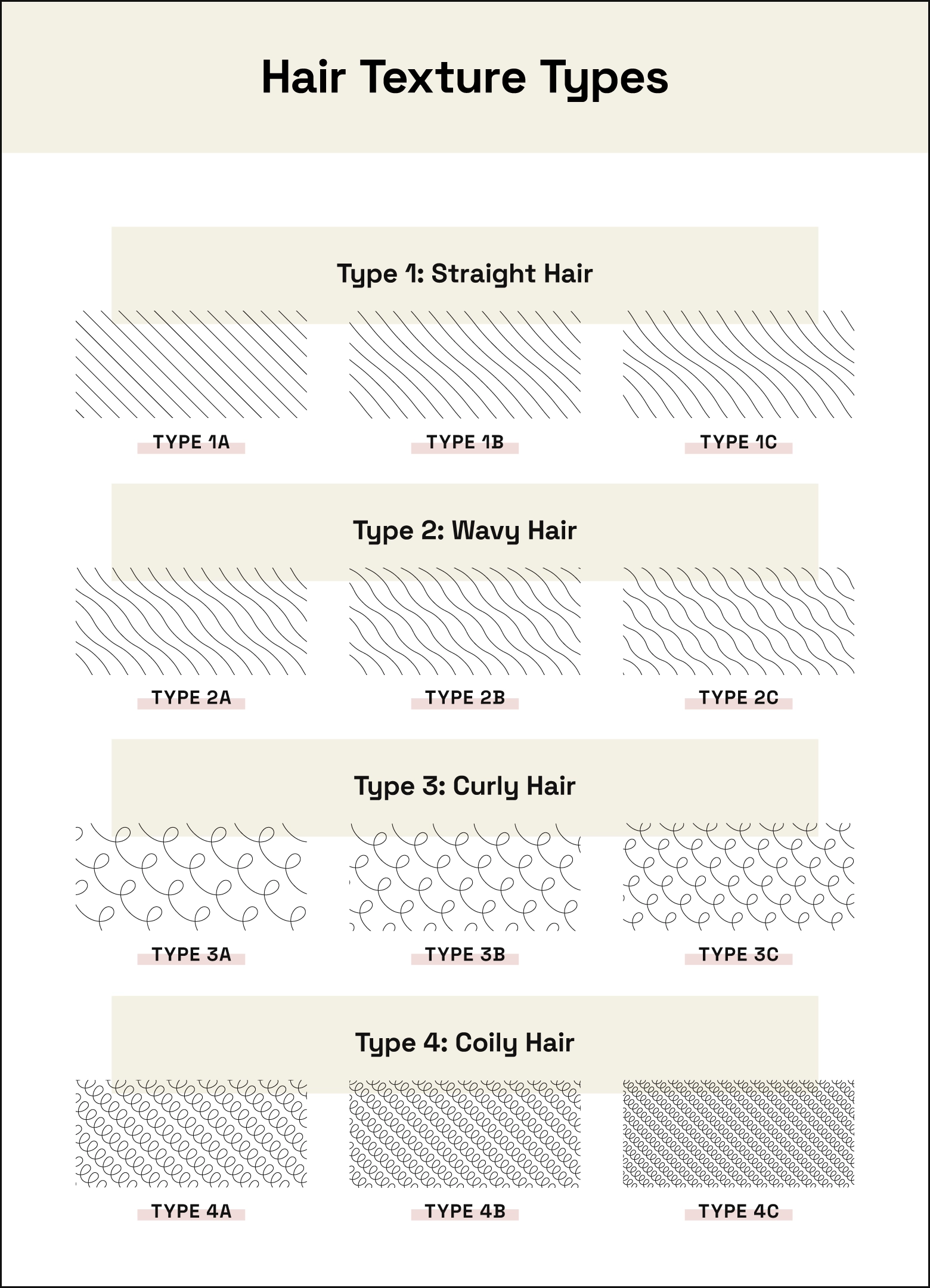
You can use our hair type chart as a guide to help you figure out which hair texture you have. There are four types of hair textures:
- Type 1: Straight
- Type 2: Wavy
- Type 3: Curly
- Type 4: Coily
Andre Walker created the original hair texture classifications in the 1990s to market his line of hair care products. Since then, many stylists and brands have adopted the original categories and created their own versions with more, less, or different hair texture types. To keep it simple, we’ll stick with these four hair types in this post.
What is a curl pattern?
There are three curl patterns: Type As have wide patterns, type Bs are medium-sized, and type Cs are the smallest. Everyone has hair textures and curl patterns. For example, someone with really tight, thick curls could have 3C hair.
What is hair porosity?
Hair porosity refers to the cuticle or outer layer of a hair strand that dictates how well your hair holds onto moisture. Both low-porosity hair and high-porosity hair can have trouble retaining moisture and might feel dry. This is because low-porosity hair doesn’t absorb moisture well, and high-porosity hair doesn’t retain moisture well. While hair damage, like from bleaching and overuse of heat, can increase your hair porosity, it’s mostly determined by your genetics.
To test for hair porosity, take a strand of clean hair and drop it into a glass of room-temperature water. You can determine your hair porosity based on what your strand does next:
- Low-porosity hair will float on top and then sink.
- Medium-porosity hair will partially sink. It won’t stay on the top or bottom of the glass.
- High-porosity hair will sink to the bottom.
If you have low-porosity hair, diluting hair products can help you keep your strands moisturized. For high-porosity hair, oil-based and leave-in products can help your hair retain moisture better.
What type of hair do I have?
You can figure out your hair texture by looking at your hair after it’s cleaned to see the shape of your strands. Look closely at your individual hair strands. For example, if your hair has a slight curve but isn’t completely curly, you probably have Type 2 hair.
You can get a sense of your curl pattern by looking at the tightness and definition of your curls, coils, or waves. For example, if you have tightly coiled hair but can still see defined curls, you probably have type B hair.
Along with texture Types 1 to 4, there are curl subtypes for each texture that go A to C. For each hair texture, A is the least curly, B is medium curly, and C is most curly.
To get an idea of which hair type you have and tailor your hair care routine, look out for:
- Individual strand shape
- Individual strand thickness
- Overall strand texture
- Overall hair thickness
We’re going to dive deep in the next section on different hair texture types. We’ll also give you some examples to help you understand your unique hair texture type.
Type 1: Straight hair
Care tip: Use a hairbrush with natural bristles to help distribute your natural oils along your strands.
Type 1 hair is straight and naturally shiny due to its shape. Natural oils flow easily from the scalp down to the ends because of the lack of curls. This also helps hair get the nutrients it needs, resulting in strong hair that’s resilient against breakage. Type 1 hair appears to grow fastest, but that’s just because there isn’t any shrinkage like with curly or coily hair types. Type 1 hair generally:
- Looks smooth and shiny
- Might appear thin overall
- Has thin-looking strands
- Doesn’t hold a curl or other texture
In exchange for strong and shiny locks, Type 1 hair tends to get oily faster than other types. It also takes extra effort to style straight hair because it doesn’t hold a curl or other texture very well.
To care for Type 1 hair, experiment with products like shampoo and hair masks. You’ll need to do some trial and error to keep your hair clean without overdoing it with products. Using fewer products can help cut down on oil production in your hair. But in order to achieve most styles, you’ll probably need some products, like texturizing spray or dry shampoo.
Hairspray will be your best friend to help you lock in styles. Volumizing products are another go-to if you want to go big with your look. You can also opt for choppy layers and fun cuts to naturally add body and volume to your hair.
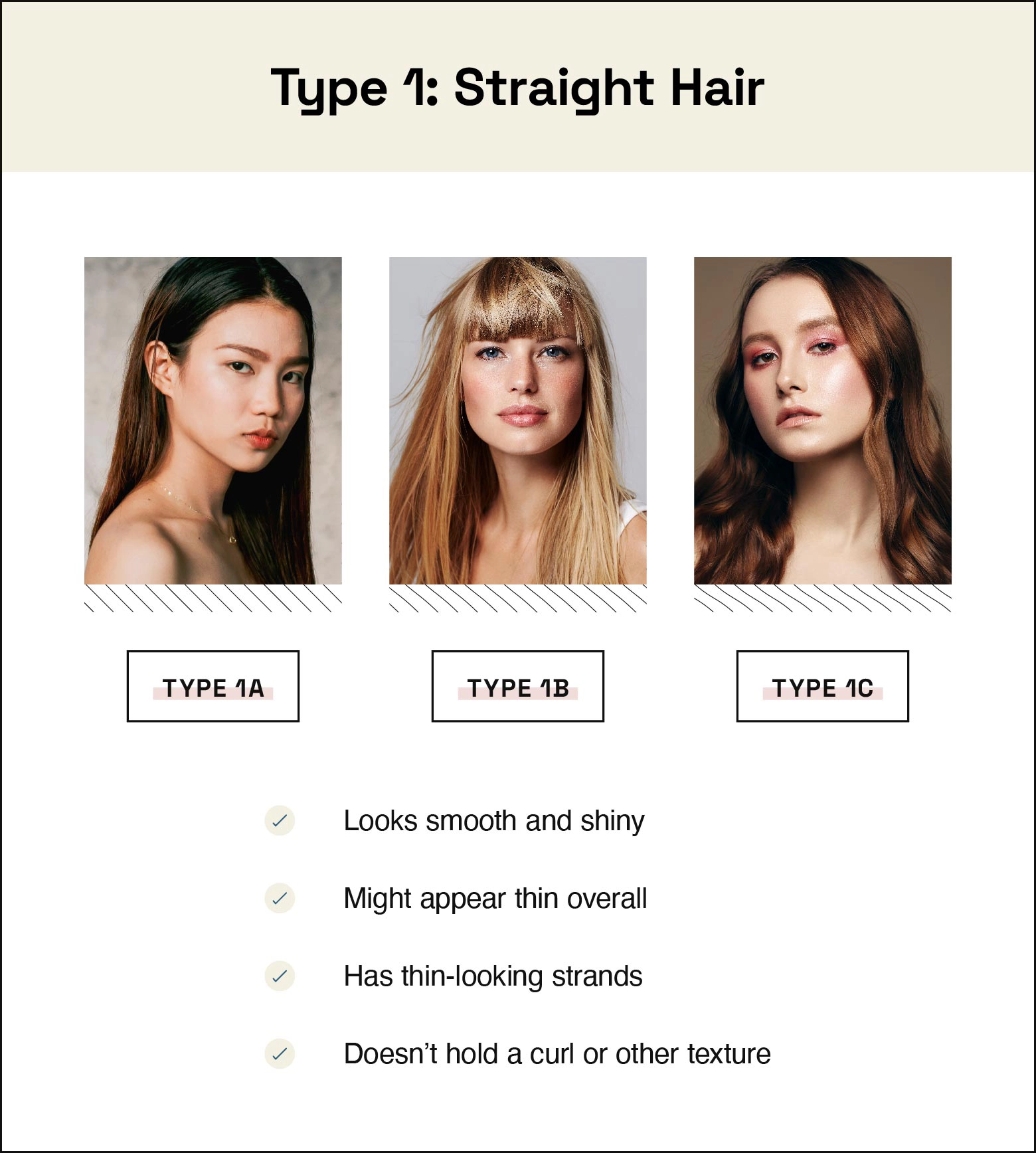
Type 1A hair
This type of hair is thin, straight, and doesn’t have any curls. This wispy hair type doesn’t have a lot of volume and doesn’t hold curls well. However, you can still experiment with different cuts and bangs to mix things up. Type 1A hair is rare because most people with straight hair have some slight curves in their strands.
Type 1B hair
Type 1B hair holds a little more volume and might curl easier compared to Type 1A hair. It’s also thicker than Type 1A, but still naturally straight. Have some fun with feathery layers or intricate updos to spice up your look. Asymmetrical bobs and other blunt cuts also look great and edgy on Type 1B hair.
Type 1C hair
This hair type is mostly straight, but sometimes it has a few waves. Layering Type 1C hair can lighten the weight of your hair while giving you a low-maintenance look you can easily style every day. Since Type 1C hair has lots of body, you can experiment with big and bold curls.
Type 2: Wavy hair
Care tip: Use a soft T-shirt or a designated hair towel after you wash your hair to prevent frizz. For best results, gently squeeze your hair dry instead of rubbing it.
Type 2 hair is wavier than Type 1 hair, but not as curly as Type 3 or Type 4 hair. Wavy hair tends to take on S-shaped patterns and can look and feel different depending on the weather. Waves and curls are more prominent the farther from the root you go. Type 2 hair is a middle ground between straight and curly hair but it still requires some specific care to keep it healthy. Type 2 hair generally:
- Has S-shaped strands
- Has thicker individual strands than Type 1 hair
- Has natural volume
- Is frizz-prone
Wavy hair tends to get frizzy. Explore shampoos and leave-in treatments to keep your hair moisturized and frizz-free. Avoid touching your hair to keep frizz to a minimum. You can also minimize frizz by using heat protectant, avoiding towel rubs, and getting regular haircuts.
Too many heavy products can especially weigh down Type 2 hair, so stick to lighter products like mousse. You should also use a light hand when you’re applying product to your hair.
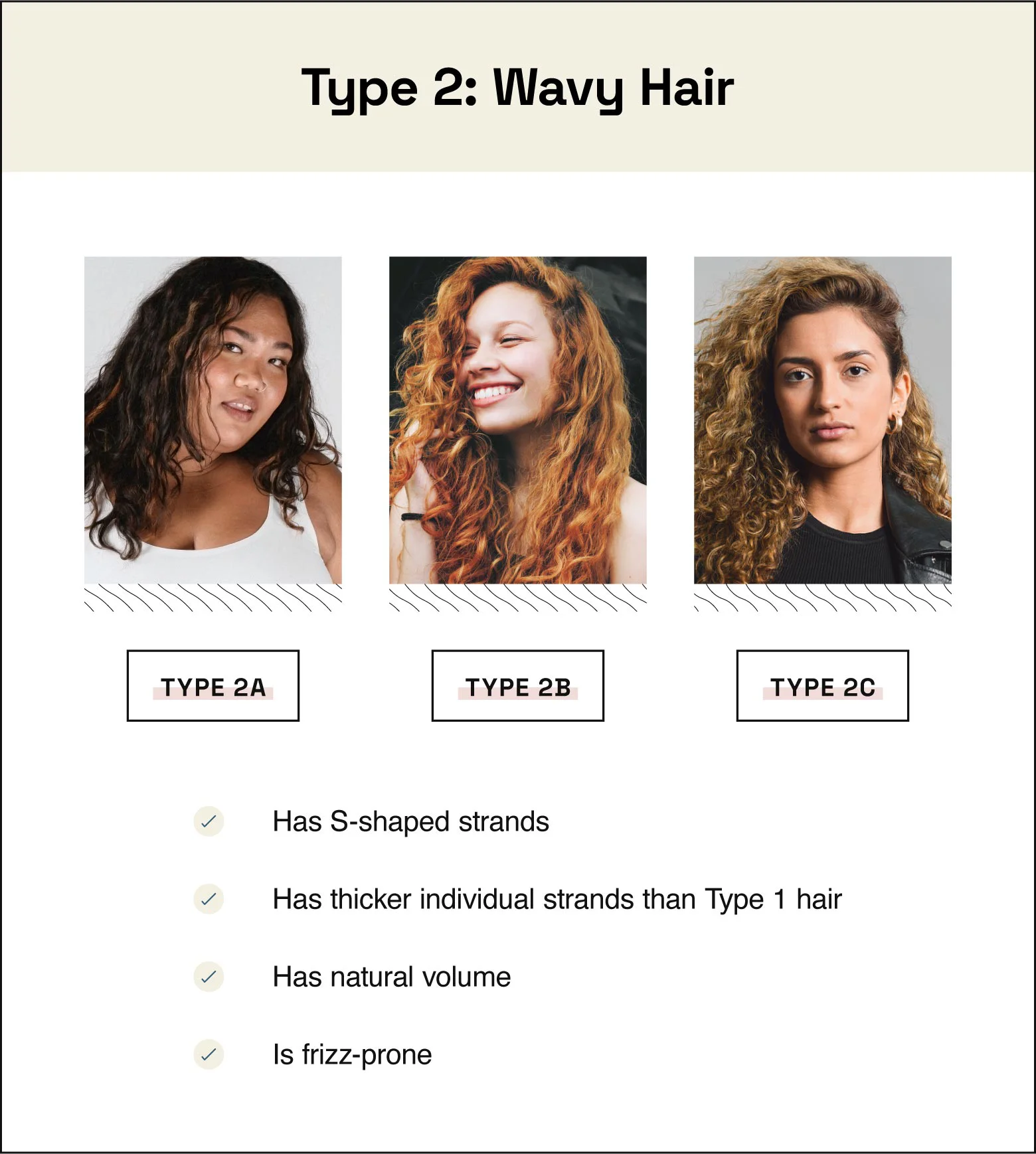
Type 2A hair
This type of hair naturally looks like beachy waves thanks to its loose, tousled curls. Products can especially weigh down 2A hair, so opt for lighter styling products like wave-defining gels. Shoulder-length cuts show off your waves well and can help make your texture a little more defined. The shorter your hair, the less weight on your strands, giving you more volume and texture.
Type 2B hair
This hair type tends to have straight hair at the roots with curls forming further down the strands. Type 2B hair has a more pronounced S-shape than Type 2A hair. One-length haircuts look great on 2B hair and can give you an extra boost of volume.
Type 2C hair
Type 2C hair walks the line between wavy and curly. 2C curls are a little tighter than 2B, but not as tight as 2A hair. This type of hair requires some extra care to fight frizz. Type 2C hair also takes some more time to style, but the right cut can give you an effortlessly chic look. Consider adding in some color to make your curls pop.
Type 3: Curly hair
Care tip: Gently detangle your hair while it’s still wet to define your curls and minimize frizz.
Type 3 hair features naturally defined curls with some sheen. This hair texture type has much more volume and body than previous types. Type 3 hair tends to go flat when wet and curls again when dry. Type 3 hair generally:
- Feels drier than hair Types 1 and 2
- Is “triangle-shaped” when brushed dry
- Is vulnerable to heat damage and breakage
- Has mostly curled strands but some might be S-shaped
This type also tends to be drier than the previous two since oil can’t easily travel down the strands. Moisture is key to keeping healthy and happy curls. You’ll need a healthy mix of anti-frizz and moisturizing products in your hair care routine. Heat styling can be especially damaging to Type 3 hair if done too often.
Instead, look into heatless styles and creative cuts to help you switch up your day-to-day look. Other protective styles like buns and twist-outs are great for protecting your hair from the elements and giving it a break from constant styling.
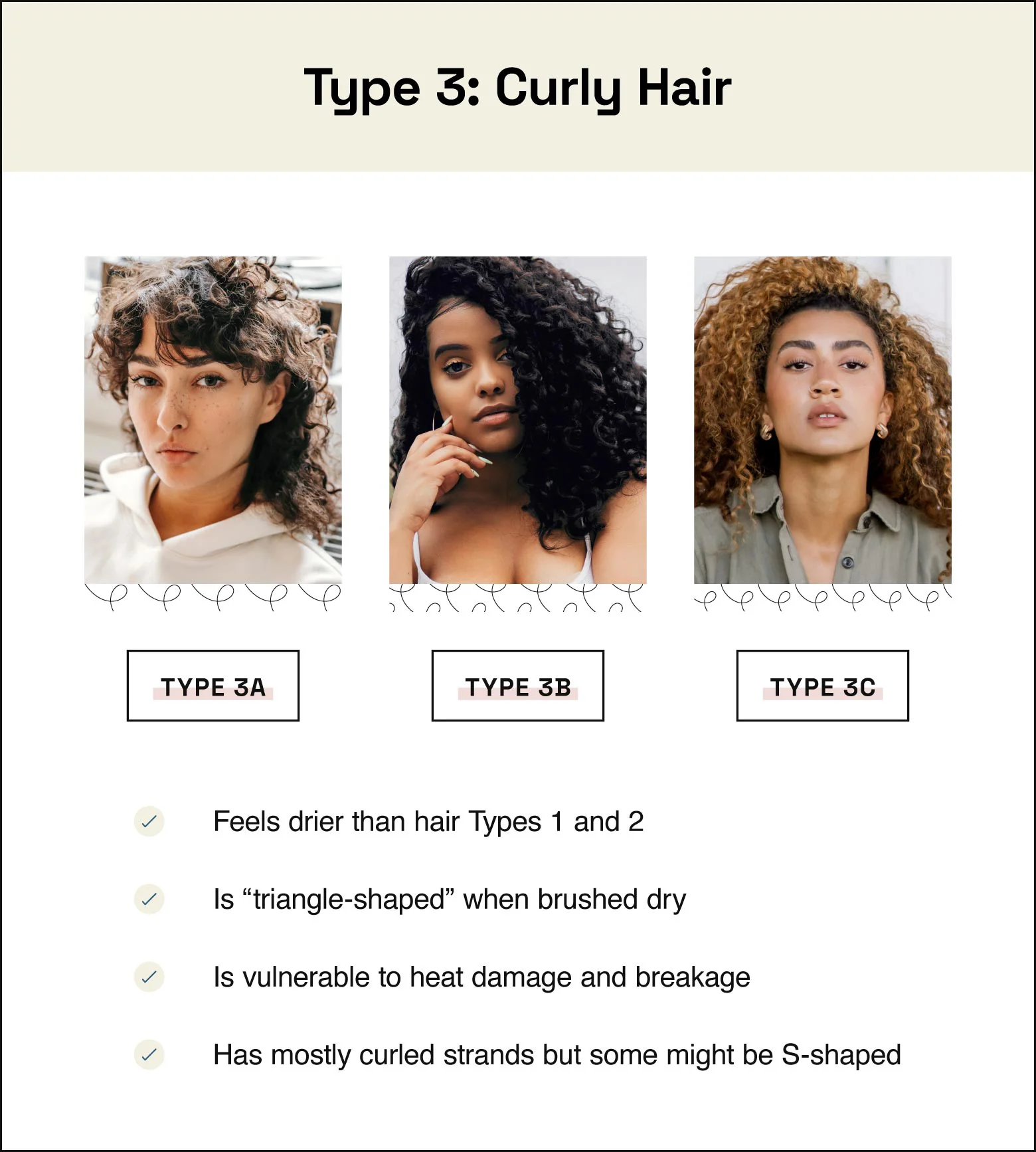
Type 3A hair
Type 3A hair has big, bouncy curls and doesn’t need much product to define it. These curls are looser compared to Types 3B and 3C hair and are about the size of sidewalk chalk. Halo braids and braided chignons look extra special with Type 3A hair since the natural curls add flair and volume to these looks.
Type 3B hair
This hair texture type has tight ringlets and lots of body. These curls are sometimes compared to the size of a marker. Pixie cuts and lobs look great with 3B hair. You can also stand out with longer hair and a deep side part or some color to emphasize your curls.
Type 3C hair
This hair type features lots of springy corkscrew curls about the size of a pencil. These tightly coiled strands give you lots of volume and movement. You can pull your curls together in a cute half-up top knot or a pineapple. 3C hair is also great for wash-and-go styles if you prefer to wear your hair down.
Type 4: coily hair
Care tip: Keep a lightweight leave-in conditioner on hand to use daily and moisturize your strands between washes.
Coily hair is versatile and beautiful, but needs some love to keep it untangled, moisturized, and healthy. This hair type is easily damaged since it’s difficult for natural oils and nutrients to travel down heavily textured strands. It’s also most prone to shrinkage when wet. Moisturizing is a must, but you also need to strike a balance between nourishing your hair and over-cleansing it with frequent washing. Type 4 hair generally:
- Has a mix of S- and Z-shaped strands with ringlets
- Is thicker overall
- Has the most hair shrinkage compared to other hair types
- Is more prone to breakage
Long-lasting protective styles like crochet braids and knotless box braids are great low-maintenance looks to protect hair from breakage. You can also add a couple twists or braids in your hair to keep it out of your face while letting the rest of your hair flow freely.
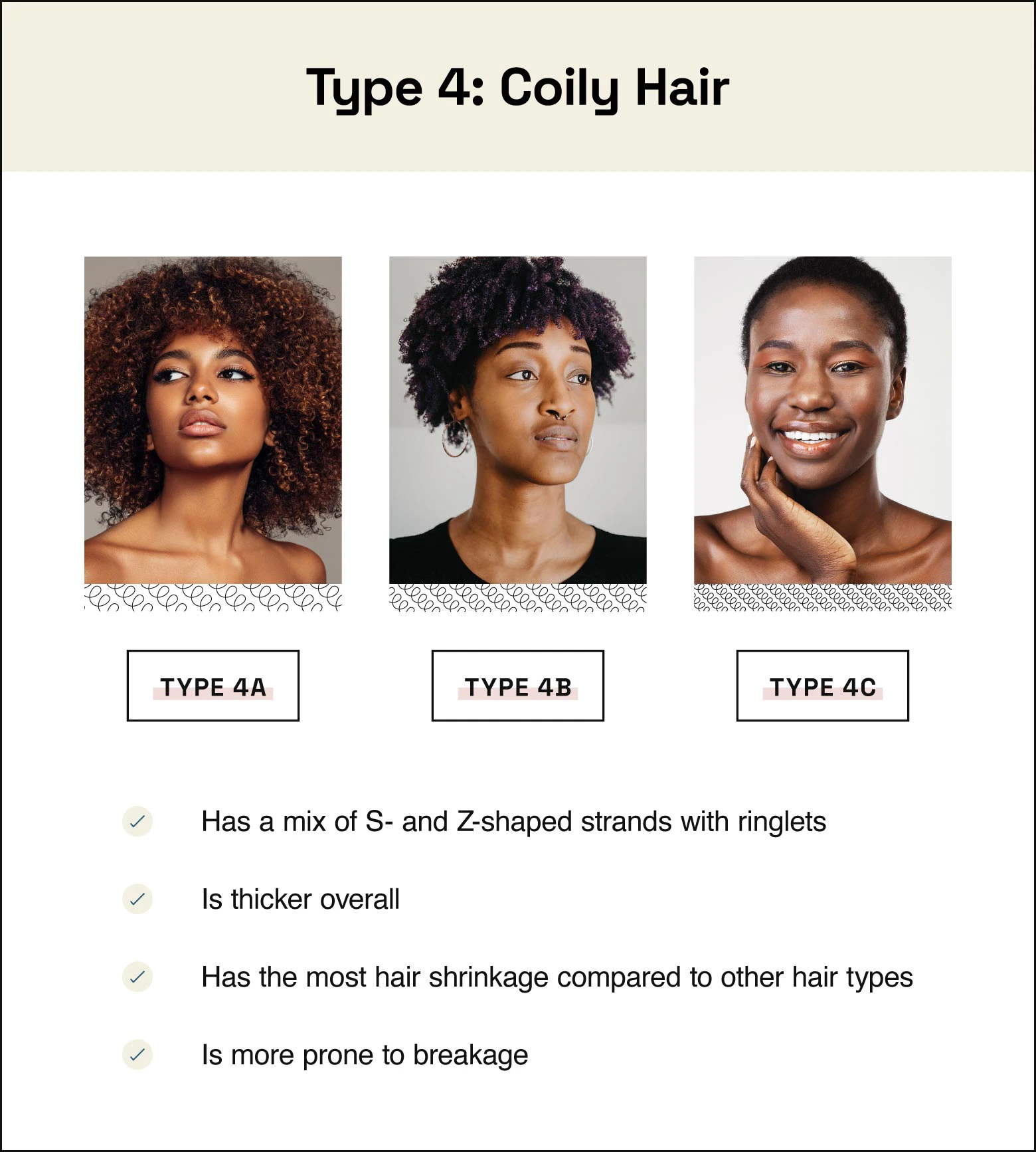
Type 4A hair
Type 4A hair tends to keep an S-shaped pattern. It has the least shrinkage and most defined curls compared to other Type 4 hair textures. If you want something different, ask your stylist about adding some bangs to your look. Curly bangs are perfect for framing your face, especially if you have your hair up.
Type 4B hair
Type 4B hair has Z-shaped strands and tight coils. These curls are very tightly coiled, so they have a little less definition compared to 4a curls. Pre-poo treatments, like adding oil to your scalp, can help you retain moisture. If you want to add more definition to your curls, flexi rods and perm rods are great choices for 4B hair. Other styles like crown braids and a tuck and roll also look stylish and embrace your natural texture.
Type 4C hair
This hair type has sharp Z-shape strands and has the least defined curl shape. It’s the thickest hair type and gets easily tangled. You’ll need to include daily moisturizing in your routine and handle your hair with care. However, your thickness is your advantage! Hairstyles like twist-outs and space buns look very chic when they have lots of body.
Can I have more than one hair texture?
Yes! Most people have more than one hair texture. You can be born with many hair textures and it can change over time. Hair coloring, diet, climate, hormones, and many other things can affect your hair texture.
Having more than one hair texture isn’t any cause for alarm. It also doesn’t mean that your hair care routine needs to be difficult. All it means is that you’ll need to pay a little more attention to your hair and how it reacts to different products. For example, some parts of your hair may need extra moisturizing than others. You can ask your hairstylist for help figuring out your textures at your next appointment.
Can I have more than one curl type?
Similar to hair texture, most people have more than one curl type. Multiple curl types can be tricky because finding the hair care that works best for you will take some trial and error. If you have a predominant curl type, tailor your routine for that type and make adjustments slowly until you’ve achieved your desired look.
To make sure all your products play nice together on your tresses, try mixing a bit of each product in the palm of your hand. If the products separate or change textures, then they might not work well together in the same routine.
Knowing your hair texture is a great place to start, but you’ll need to do more research to learn what products and hair care steps work best for you before trying a new look. It’s also important to remember that specific products and treatments that work for your friends may not work for your hair. If you’re still unsure, you can chat with a stylist near you to get expert guidance while you’re experimenting with treatments and styles.
